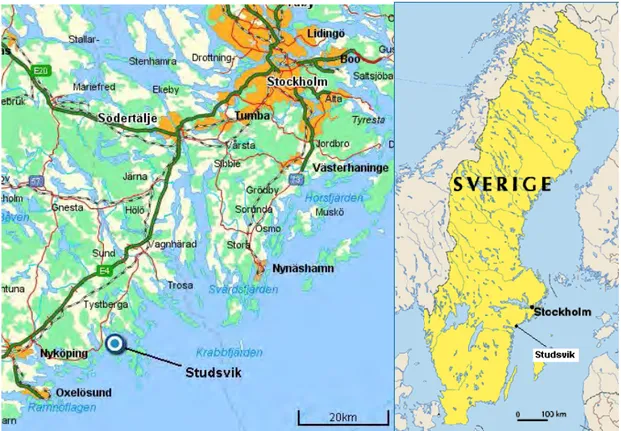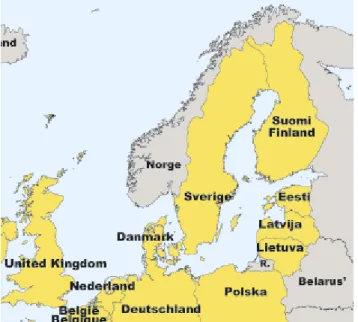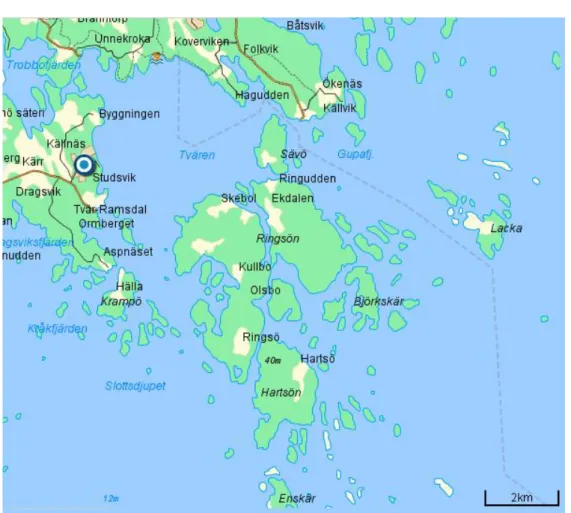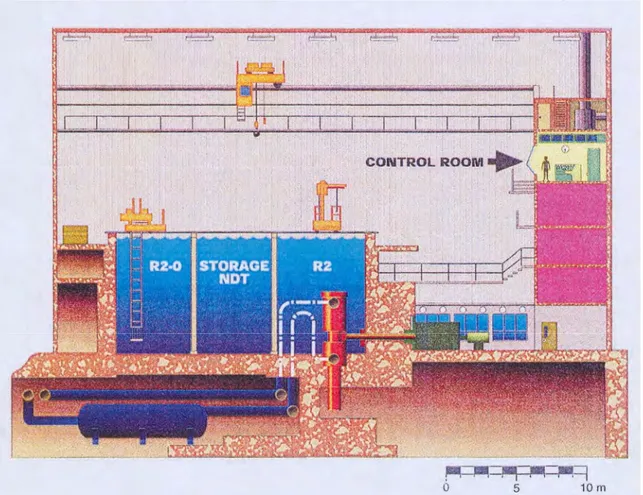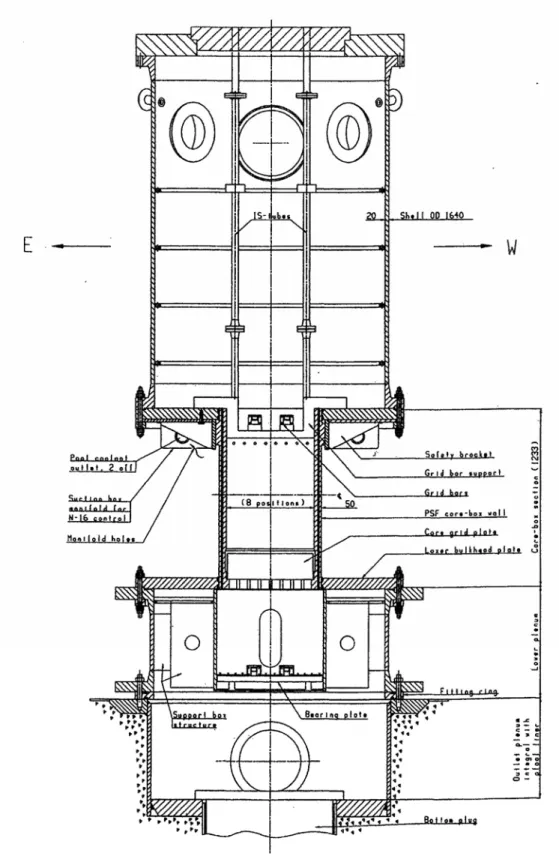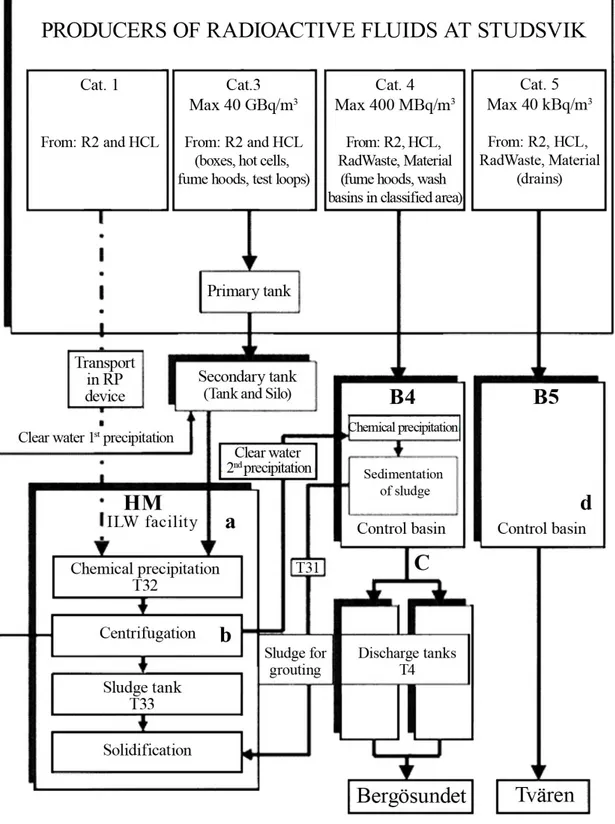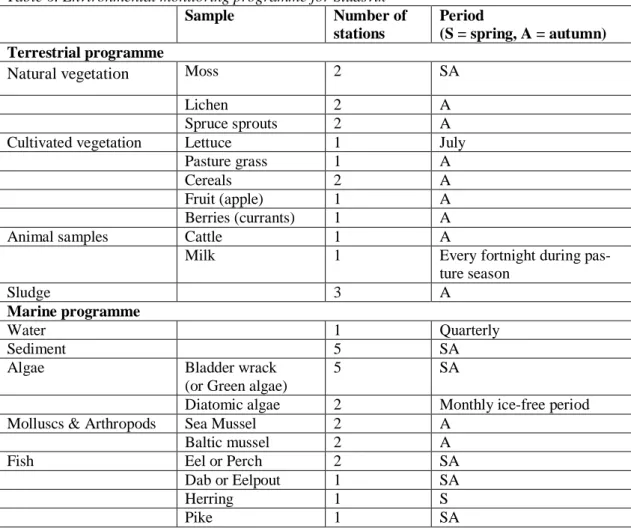Decommissioning of the Nuclear
Reactors R2 and R2-0 at Studsvik,
Sweden – General Data as called for
under Article 37 of the Euratom Treaty
Title: Decommissioning of the Nuclear Reactors R2 and R2-0 at Studsvik, Sweden – General Data as called for under Article 37 of the Euratom Treaty
Report number: 2009:01 Date: January 2009 Abstract
The report describes the plans for decommissioning of the nuclear research and material test reactors R2 and R2-0, situated at the Studsvik site in Sweden. The purpose of the document is to serve as information for the European Commission, and to fulfil the requirements of Article 37 of the Euratom Treaty. According to Article 37, each Member State shall provide the Commission with such general data as will make it pos-sible to determine whether the planned activities are liable to result in radioactive contamination of another Member State.
Content
Introduction ...3
1. The site and its surroundings ...5
1.1 Geographical, topographical and geological features, land use and distances to neighbour Member States...5
1.2 Hydrology...7
1.3 Meteorology ...7
1.4 Natural resources and foodstuffs...8
2. The installation...9
2.1 Brief description and history of the installation ...9
2.2 Ventilation systems and the treatment of gaseous and airborne wastes...12
2.3 Liquid waste treatment...12
2.4 Solid waste treatment ...14
2.5 Containment...14
3. Release of airborne radioactive effluents in normal conditions .15 3.1 Authorisation procedure in force...15
The Environmental Code ...15
Radiation Protection Law ...15
Act on Nuclear Activities ...15
3.2 Technical aspects ...16
3.3 Monitoring of discharges ...16
3.4 Evaluation of transfer to man...16
4. Release of liquid radioactive effluents under normal conditions ... ...18
4.1 Authorisation procedure in force...18
4.2 Technical aspects ...18
4.3 Monitoring of discharges ...18
4.4 Evaluation of transfer to man...19
5. Disposal of solid radioactive waste...20
5.1 Categories of solid radioactive wastes and estimated amounts ..20
5.2 Processing and packaging ...20
5.3 Storage arrangements...21
5.4 Radiological risks to the environment, precautions taken ...21
5.5 Arrangements for the movement and destinations of classified waste transferred off-site ...21
5.6 Criteria for contaminated materials to be released from the requirements of the Basic Safety Standards, for disposal, recycling or reuse ...22
5.7 Envisaged types and amounts of released materials...23
Metal scrap...23
Waste for disposal on municipal dump or reuse as filling ...23
6. Unplanned releases of radioactive effluents ...24
6.1 Review of accidents of internal and external origin which could result in unplanned releases of radioactive substances...24
6.2 Reference accidents taken into consideration by the competent authorities for evaluating possible radiological consequences in the case of unplanned releases...25
6.3 Evaluation of the radiological consequences of the reference accidents ...25
2
7. Emergency plans; agreements with other Member States ...26 8. Environmental monitoring...27 9. References...29
Appendices
1. Overview of the Studsvik site 2. Overview of the reactor facility
Introduction
This document describes the plans for decommissioning of the nuclear research and material test reactors R2 and R2-0, situated at the Studsvik site close to the city of Nyköping, Sweden. The purpose of the document is to serve as informa-tion for the European Commission, and to fulfil the requirements of Article 37 of the Euratom Treaty, according to which:
“Each Member State shall provide the Commission with such general data relat-ing to any plan for disposal of radioactive waste in whatever form as will make it possible to determine whether the implementation of such plan is liable to result in the radioactive contamination of the water, soil or airspace of another Member State.”
The Commission has recommended that “disposal of radioactive waste” should cover any planned disposal or accidental release of radioactive substances asso-ciated with, among other activities, the dismantling of nuclear reactors (Com-mission Recommendation 1999/829/Euratom of 6 December 1999).
The document has been produced by the Swedish Radiation Safety Authority mainly based on information given by the operator Studsvik Nuclear AB. Trans-lation and adaptation of the information was performed by Vattenfall Power Consultants AB. The structure of the document follows the recommendation given in Annex 2 of the above mentioned recommendation from the Commis-sion.
Studsvik is situated on the Baltic coast, about 20 km east of Nyköping and 80 km southwest of Stockholm. The site comprises the reactors R2 and R2-0 and several facilities for material investigation and radioactive waste treatment and storage. The reactors were used for a number of different purposes from 1960 until June 2005, when they were shut down following a decision by the operator. Decommissioning of the reactor facility is planned to be completed in 2016 after dismantling and conditioning of radioactive parts and demolition of the facility. Solid and liquid radioactive wastes from the dismantling activities will be treated and stored on-site awaiting final disposal. The waste treatment facilities, which are situated in other buildings at the Studsvik site, are planned to continue operation during and after the decommissioning of the reactor facility.
All nuclear fuel has been transferred to a separate storage facility and is being shipped to the US according to existing agreements.
The objective of the planned dismantling activities is to achieve clearance of the facility to make it possible to either demolish the buildings or use them for other purposes.
4
The operator has divided the planning for dismantling and demolition of the facility into three phases [1]:
Dismantling 1, including primary system decontamination, dismantling of the reactors with systems in the reactor pool, draining, cleaning and temporary covering of the reactor pool. This phase has begun and it’s due to last till approximately December 2009.
Dismantling 2, including dismantling of systems in the reactor facility, removal of equipment, radiological surveys, removal of contaminated or activated parts of building structures, cleanup of contamination and clearance measurements of the buildings. This phase reaches from ap-proximately January 2010 till June 2015.
Demolition, including remediation after clearance of the facility. This phase reaches from approximately July 2015 till December 2016. Decommissioning of a nuclear reactor facility requires a license according to the Environmental Code (1998:808), A license for the full decommissioning project was issued on March 16, 2007 by the Environmental Court in Stockholm [13]. According to the Swedish Nuclear Power Inspectorate’s Regulations (SKIFS 2004:1) concerning Safety in Nuclear facilities, a decommissioning plan shall be supplemented and incorporated in the Safety Analysis Report (SAR) before the dismantling of the facility may be initiated. The revised SAR [10, 11] has been submitted to SKI in June 2007. After review, the SKI has pointed on several areas which need to be developed further before the SAR can be approved. According to the Swedish Radiation Protection Authority’s Regulation (SSI FS 2002:4) on Planning for and during Decommissioning of Nuclear Facilities, the licensee shall submit a detailed report four months before dismantling and demolition of systems or facility parts containing radioactive materials. The report [12] has been submitted to SSI in June 2007. The report, among other things, covers a time schedule, a review on chemical and toxic material in the facilities, induced activity, volumes and handling of radioactive waste, docu-mentation, organisation, methods and equipment for demolition, discharge con-trol and a preliminary estimate of the collective dose. After review, the SSI has pointed on several areas which need to be developed further before dismantling of the reactors may take place.
From July 1, 2008, the tasks of the Swedish Nuclear Power Inspectorate (SKI) and the Swedish Radiation Protection Authority (SSI) have been taken over by the Swedish Radiation Safety Authority (in Swedish:
Strålsäkerhets-myndigheten, SSM), a new authority formed by a merge of SKI and SSI. As a consequence of this, the SSI and SKI regulations of decommissioning issues will be revised.
1. The site and its
surround-ings
1.1 Geographical, topographical and
geo-logical features, land use and distances to
neighbour Member States
The Studsvik site is situated 20 km east of Nyköping and 80 km southwest of Stockholm in Sweden (Figure 1).
The site coordinates are N 58° 46’, E 17° 23’. There are several facilities for material investigation and radioactive waste treatment and storage at the site. A small number of other companies are located to the site or its immediate sur-roundings. An overview of the site is given in Appendix 1.
Figure 1. Studsvik
The reactor facility is placed on moraine, sand and gravel on a bedrock of sedi-mentary vein gneiss. The area is seismically stable and there is no risk of dam-age to the facility due to earthquakes.
There are nature reserves as well as Natura 2000- areas in the near surroundings. A small residential area lies immediately south of the site. Three other residen-tial buildings are situated in a distance of 1.5 kilometres. Otherwise the sur-roundings are sparsely populated.
6
The archipelago has high natural values. Different forms of outdoor life are common in the area [2].
Neighbour Member States are shown in Figure 2. Distances to neighbour state borders are given in Table 1.
Figure 2. Neighbour Member States.
Table 1. Approximate distances to neighbour state borders.
State Distance to border from Studsvik (km)
Finland (Åland) 400 (230) Estonia 400 Latvia 350 Poland 450 Germany 520 Denmark 400 Norway 320 SSM 2009:01
1.2 Hydrology
The site is drained eastwards through smaller ditches to the bay Tvären, which is part of the Baltic Sea. See Figure 3. Average drainage is 0.20 m3/(m2·year).
Figure 3. The bay Tvären, part of the Baltic Sea.
Tvären (area 18 km2, average depth in the upper part 12 meters, overall deepest point 80 meters) is marked off from the open sea by thresholds with no greater depth than 10 meters. The water turnover in the upper layers of Tvären (depth less than 10 meters) is 20 million m3/day [3].
1.3 Meteorology
Winds from southwest and west predominates the area. In the winter, northwest winds are quite common as well (December till February). Average wind speed at 72 meter is about 6 m/s, at 36 meter 4 m/s. Wind speeds are somewhat higher in the autumn and in the winter.
Average precipitation is 650 mm/y, average intensity 0.5 mm/h. Average temperature during period of growth is 12°C [2, 3].
8
1.4 Natural resources and foodstuffs
Corn (cereals and feeding grain), pasture, vegetables and root vegetables are cultivated in the surroundings. The period of growth lasts about 180 days. Esti-mated average production is shown in Table 2 [3].
Table 2. Average production of crops.
Crop Average production (kg/m2)
Cereals 0.41
Feeding grain 0.38
Pasture 0.43
Vegetables 2.26
Root vegetables 3.6
Commercial fishing occurs in a small extent in the bay Tvären and the near sur-roundings in the Baltic Sea. Angling is an increasing leisure pursuit.
Studsvik Nuclear AB produces its own fresh water by purifying water from the lake Trobbofjärden. The capacity of the water purification plant is 20 m3/h [5].
2. The installation
2.1 Brief description and history of the
instal-lation
The nuclear research facility was built during the late 1950ies and was com-pleted in 1960. The nuclear research and material test reactors R2 and R2-0 are situated in a common reactor pool. R2 is a tank type reactor and R2-0 is a mo-bile pool reactor. The R2 had a thermal power of 50 MW and the thermal power of R2-0 was 1 MW. The R2 reactor was used for fuel testing, studies of corro-sion, radiography and production of radioisotopes, semi conducting materials and neutrons used in basic research. The R2-0 reactor was used as a neutron source for treatment of patients with brain tumours (Boron Neutron Capture Therapy) and for educational purposes. The reactors were shut down in June 2005 following a decision by the operator [1, 2].
The reactor building is located approximately 100 metres from the shore. The floor of the reactor hall is 15.7 metres above sea level. The liquid waste treat-ment facility is built on a slightly lower level to assure a falling gradient. The two reactors R2 and R2-0, like many of the supporting systems, are situated inside the reactor building. Pumps, heat exchangers, store tanks, fan systems etc. are situated inside an adjacent pump station. The fan system is connected to a separate 85 meter stack. There are also buildings for service, laboratory, experi-ments and other supporting activities. See Appendix 2.
Inside the reactor hall there is a water filled reactor pool where both R2 and R2-0 are located. See Figures 4 and 5.
The main radioactive parts of the facility are the reactor structures and the pri-mary systems. The activity of the reactor structures has been estimated by calcu-lations and will be verified during dismantling. The degree of radioactive con-tamination of the systems has so far mainly been investigated by dose-rate measurements. Initial characterization by smear samples has been made of con-tamination on operational waste and (mainly) outer surfaces of systems. Pre-liminary results show different nuclide distributions in different samples, with-out any systematic change between different sample positions. However, ac-cording to estimations by the operator, most of the radioactive waste that will be produced will be low-level (<2 mSv/h).
10
Figure 4. Cross-section of the reactor hall with the two reactors R2 and R2-0.
12
2.2 Ventilation systems and the treatment of
gaseous and airborne wastes
The ventilation systems of the facility direct the air flows towards premises with higher risk of airborne activity. Ventilation systems in areas where there is risk of airborne activity are called active systems. The active systems evacuate four different areas; the basement, the so called pipe gallery, the ion exchanger room and the emergency evacuation system. The air from each area is collected into a ventilation channel (flue) where it passes filters for aerosols. The four flues lead the air to the top of the 85 meters high stack, where the air is released. In each flue, the air flow is provided by a fan that is doubled by a reserve fan. The sys-tem includes automatic start of a reserve fan and prioritised power supply to assure the correct pressure distribution in the premises in case of loss of normal power supply.
Roof-fans evacuate the air in the reactor hall. There is also a possibility to venti-late the reactor hall through the emergency evacuation system. The emergency ventilation system contains an iodine scrubber, which was designed to reduce the release of iodine in case of an accident during reactor operations. Although there will be no potential for releases of iodine during dismantling, the iodine scrubber will be in function during dismantling for filtration of air in connection with certain dismantling activities in the reactor hall.
2.3 Liquid waste treatment
Liquid wastewater arising during dismantling will be taken care of in an adja-cent facility for treatment of intermediate level waste, operated by AB SVAFO and in control pools operated by Studsvik Nuclear AB. Wastes are transported in pipes in an underground culvert. The culvert system is used by other facilities at the site and will remain in operation throughout the dismantling of the reactor facility.
An overview of the process is given in Figure 6. The liquid waste will be treated by precipitation and centrifugation. The remaining water phase will be treated by precipitation, sedimentation and ion exchange. Organic compounds that may occur in liquid waste from system decontamination will be broken down by UV oxidation [16]. Sludge from the process will be solidified with cement in drums. Liquid waste with higher activity concentration than accepted in the culvert system can be transported in radiation protective flasks to the facility for treat-ment of intermediate level waste for immobilization. It is not expected that such liquids will arise during the dismantling activities.
After analysis, the wastewater from the facility for treatment of intermediate level waste is discharged into the bay Bergösundet.
Figure 6. Principle flow diagram for treatment of liquid waste in Studsvik The letters indicate where samples are normally taken from the process; arrival (a), clear water (b) and before discharge (c and d).
14
2.4 Solid waste treatment
All solid wastes will be treated and stored in Studsvik awaiting final disposal. In this section, a brief description is given. Processing and packaging is described in more detail in Section 5.2 below.
Low-level scrap-metal will be transferred to the melting facility at Studsvik, operated by Studsvik Nuclear AB.
Low-level combustible waste will be transferred to the incineration facility at Studsvik, operated by Studsvik Nuclear AB.
Low-level, non-combustible waste will be conditioned and stored at Studsvik awaiting final disposal.
All low-level solid waste is planned to be disposed of in the planned repository for radioactive decommissioning waste (SFR-3, see Section 5.5).
Low- and intermediate-level long-lived solid waste will be transferred to the facility for treatment of intermediate-level waste in Studsvik, operated by AB SVAFO. The waste is planned to be deposited in the planned repository for long-lived waste (SFL, see Section 5.5).
The facilities mentioned above have all been licensed according to the Environ-mental Code and the Act on Nuclear Activities [1].
2.5 Containment
The reactors are enclosed in a concrete containment. The containment is not completely gas-proof but the ventilation system guarantees underpressure (see Section 2.2 above).
3. Release of airborne
ra-dioactive effluents in
normal conditions
3.1 Authorisation procedure in force
The Environmental Code
In January 2006 Studsvik Nuclear AB applied at the Environmental Court of Stockholm for a license according to the Environmental Code for dismantling the R2-facility. The Court referred the application to - among others - Swedish Nuclear Power Inspectorate, Swedish Radiation Protection Authority, County Administrative Board of Södermanland and the Municipality of Nyköping. License was given March 16, 2007. The Environmental Court did not state any conditions concerning radioactive effluents. The court refers to the Radiation Protection Law and the Act on Nuclear Activities and related regulations, see below.
In the license it is stated that decommissioning shall be carried out in accordance with the schedule for the so called “main alternative”, i.e. decommissioning shall be completed before the end of 2016 [13].
Radiation Protection Law
Release of radioactive substances to the environment from nuclear facilities is regulated by the Swedish Radiation Protection Authority’s Regulations (SSI FS 2000:12) on Protection of Human Health and the Environment from Releases of Radioactive Substances from Certain Nuclear Facilities. According to the regu-lations, best available technique shall be applied to reduce the releases. Effective doses to the critical group due to the releases in one year shall not exceed 0.1 mSv (integrated over a period of 50 years).
According to the Swedish Radiation Protection Authority’s Regulation (SSI FS 2002:4) on Planning for and during Decommissioning of Nuclear Facilities, the licensee shall submit a detailed report four months before dismantling and demolition of systems or construction parts containing radioactive materials. The report [12] has been submitted to the Swedish Radiation Protection Author-ity (SSI) in June 2007. The report, among other things, covers a time schedule, a review on chemical and toxic material in the facilities, induced activity, volumes and handling of radioactive waste, documentation, organisation, methods and equipment for demolition, release control and a preliminary estimate of the col-lective dose. After review, the SSI has pointed on several areas which need to be developed further before dismantling of the reactors may take place.
Act on Nuclear Activities
Studsvik Nuclear AB holds a license for possession and operation of the reactors R2 and R2-0 according to the Act on Nuclear Activities. The license is valid
16
also for decommissioning of the reactors. According to the Swedish Nuclear Power Inspectorate’s Regulations (SKIFS 2004:1) concerning Safety in Nuclear facilities, a decommissioning plan shall be supplemented and incorporated in the Safety Analysis Report before the dismantling of the facility may be initiated. The revised Safety Analysis Report [10, 11] has been submitted to the Swedish Nuclear Power Inspectorate (SKI) in June 2007. After review, the SKI has pointed on several areas which need to be developed further before the SAR can be approved.
3.2 Technical aspects
Estimated doses to the critical group due to airborne releases from the reactor facility are estimated to be less than 1E-6 mSv/y during Dismantling 1 and less than 1E-7 mSv/y during Dismantling 2.
The contribution to doses to the critical group due to releases of liquid effluents after treatment of wastewater from the reactor facility is estimated to be less than 0.001 mSv/y.
3.3 Monitoring of discharges
Monitoring of discharges during dismantling activities will continue in almost the same way as during operation. (Since the nuclear fuel has been removed from the facility, noble gases are no longer analyzed by periodic sampling in the stack).
Airborne discharges from the stack are continuously supervised by β- and γ-monitors. A sample (1/1000 of the evacuated volume from each of the four flues) is sucked through a mixing chamber to a measure chamber where the monitors are installed.
Monitoring of aerosols is carried out by sampling in combined aerosol and char-coal filters that are connected to the flues in the stack. The filters are replaced and analysed once a week. Analyses are made for total alpha activity (detection limit 5E-3 Bq) and by gamma spectrometry (detection limit 5 Bq for Co-60 and Cs-137). If the released alpha activity exceeds 100 Bq per week, alpha spec-trometry is performed. The charcoal filters are analyzed for I-131.
Airborne activity in the exhaust air from the reactor hall is monitored in connec-tion with the roof-fans by equipment for aerosol sampling on paper filters and measurement of total alpha, beta and gamma activity (Edgar equipment, alarm levels 0.02 Bq/m3 for alpha, 70 Bq/m3 for beta and 25 microGy/h for gamma). The occurrence of airborne tritium is supervised by continuous monitoring by ion chamber detectors in several places of the facility (alarm level 1.25 MBq/m3).
3.4 Evaluation of transfer to man
Effective dose to the critical group has been calculated integrated over a 50 year period from release of 1 Bq/year of every radionuclide. This has resulted in nu-clide specific dose coefficients that can be multiplied with the annual release of radioactive nuclides to obtain the committed effective dose from the releases in
the actual year. Different age groups have been considered as well as local con-ditions concerning housing and where crops are grown. Uncertainty analyses have been carried out [3].
When establishing dose coefficients for airborne releases several ways of expo-sure have been considered [3]:
- External dose caused by external exposure from clouds
- External dose caused by external exposure from activity on ground - Internal dose from inhalation
- Internal dose from intake of vegetables, root-vegetables, fruit, garden berries, crops, meat, milk, game meat, mushrooms, forest berries, lake water and fresh water fish.
18
4. Release of liquid
radioac-tive effluents under
nor-mal conditions
4.1 Authorisation procedure in force
See Section 3.1 for general description of legislation and authorisation proce-dures.
The Environmental Court has not stated any conditions concerning radioactive effluents for the license according to the Environmental Code. The court refers to the Radiation Protection Law and the Act on Nuclear Activities and related regulations [13].
4.2 Technical aspects
Liquid wastes arising during dismantling will be treated in the facilities for treatment of intermediate level waste at Studsvik (see Section 2.3 above). The amount of liquid wastes during dismantling is estimated to about 300 m3/y, mainly low level (less than 370 MBq/m3 according to the Studsvik categoriza-tion scheme). About 20 m3/y is expected to be of category 3, which requires special treatment due to higher activity content.
In 2006 and 2007, about 20 m3/y of waste of category 3 from R2 was treated in Studsvik. After treatment the remaining water phase is categorized as category 4. The total amount of category 4 waste from all facilities at Studsvik released to Bergösundet in 2006 was 2 500 m3 containing 1.5 TBq, mainly tritium (98%), Sr-90 (2%), Co-60 (0.1%) and Cs-137 (0.1 %). The total alpha activity was less than 0.01% of the total activity. After shut down of the reactors, the released activity has decreased by at least a factor of 10 000 for the dominating nuclides (except for Sr-90, which has decreased by a factor of 1000).
4.3 Monitoring of discharges
In normal conditions, the liquid radioactive effluents will be treated in the facili-ties for treatment of intermediate level waste at Studsvik (see Section 2.3). After treatment, the water is transferred to discharge tanks T4 (see Figure 6) and sam-pling is made for activity control. A sample of 5 litres is taken from every 130-140 m3 that is transferred to the discharge tanks. A subsample (3 ml) is analyzed for total alpha and total beta activity before release to the recipient. From all samples during one month, a common, weighted sample is formed, which is analyzed for total alpha activity (detection limit 0.002 Bq/ml), gamma emitting nuclides (detection limit 0.005 Bq/ml for Co-60 and Cs-137) and tritium (detec-tion limit 5 Bq/ml). Collected samples from every half a year are analyzed for Sr-90 and by alpha spectrometry. The releases from the control basin B5 (see Figure 6) are monitored according to the same methodology.
4.4 Evaluation of transfer to man
Effective dose to the critical group has been calculated with the same methodol-ogy as for airborne activity, see section 3.4 above.
When establishing dose coefficients for release to water, the following ways of exposure have been considered [3]:
- External dose during beach activities (all age groups)
20
5. Disposal of solid
radioac-tive waste
5.1 Categories of solid radioactive wastes
and estimated amounts
Scrap metal for direct clearance (no need for special treatment foreseen), esti-mated amount 50 tonnes. For clearance levels, see section 5.6 below.
Scrap metal for melting in the melting facility, estimated amount 120 tonnes (of which some can be cleared after melting). For clearance levels, see section 5.6 below.
Low-level combustible secondary waste, estimated amount 50 tonnes (approxi-mately 5 tonnes after combustion).
Low-level waste from contaminated systems, for disposal in the planned reposi-tory for radioactive decommissioning waste (SFR-3, see Section 5.5), estimated amount 6 tonnes.
Low-level waste from demolition of building constructions, for disposal in SFR-3, estimated amount 3300 tonnes.
Activated reactor components and heavily contaminated system parts, for dis-posal in the planned repository for long-lived low- and intermediate level waste (SFL, see Section 5.5), estimated amount between 7 and 20 tonnes.
5.2 Processing and packaging
Low-level scrap-metal will be transferred to the melting facility at Studsvik, operated by Studsvik Nuclear AB. In the facility, cutting, decontamination by blasting and melting can be done. The resulting ingots are subject to clearance and recycled in the steel industry. Ingots that need to decay before clearance may be stored at Studsvik. Slag and other wastes from the process, as well as scrap-metal and ingots with to high levels of radioactivity for clearance will be packed and stored at Studsvik awaiting final disposal.
Low-level combustible waste will be transferred to the incineration facility at Studsvik, operated by Studsvik Nuclear AB. The ashes from the incineration are filled in 100 litres drums that are casted with concrete in 200 litres drums. Low-level non-combustible waste will be packed in ISO-containers and stored at Studsvik awaiting final disposal. Packaging will be performed either in the reac-tor facility or in the incineration facility at Studsvik.
All low-level solid waste is planned to be disposed of in the planned repository for radioactive decommissioning waste (SFR-3, see Section 5.5).
Activated reactor components will be segmented in the reactor pool before being transferred to the facility for treatment of intermediate-level waste in Studsvik, operated by AB SVAFO. After further segmentation, the waste will be packed into 80 litres drums, which will be placed in concrete containers with positions for five drums for further storage in Studsvik. It is possible that other containers will be used. Intermediate-level solid waste is planned to be treated in a similar way. The waste is planned to be deposited in the planned repository for low- and intermediate-level long-lived waste (SFL, see Section 5.5).
5.3 Storage arrangements
All solid waste will be stored in Studsvik until the planned repositories have been taken into operation. There are several alternatives for temporary storage at the site; an underground cavern, storage buildings or in containers on hard sur-face outdoors. Waste due for SFL will be stored in the cavern [16].
5.4 Radiological risks to the environment,
precautions taken
No significant radiological risks to the environment have been predicted due to treatment or storage of solid radioactive waste [2].
5.5 Arrangements for the movement and
destinations of classified waste transferred
off-site
According to present plans, radioactive waste from decommissioning of the R2 facility will be disposed of in two different facilities that are planned by the Swedish Nuclear Fuel and Waste Management Co (SKB), see Table 3 [17]. Table 3. Estimated volumes of radioactive waste for disposal from decommis-sioning of the reactor facility at Studsvik.
Repository Category of waste Weight
(tonnes)
Volume (m3) SFR-3 (planned) Short-lived
low- and intermediate level waste
3300 3700
SFL (planned) Long-lived
low- and intermediate level waste
15 28
In Sweden, SKB is responsible for development, planning and construction of facilities for final disposal of radioactive waste from nuclear power plants. SKB is jointly owned by the Swedish nuclear power licensees. By agreement with Studsvik Nuclear AB, SKB is also responsible for arranging final disposal of nuclear waste from facilities operated by Studsvik Nuclear AB, for example the R2 facility.
SKB operates a central interim storage facility for spent nuclear fuel (Clab) and a repository for low- and intermediate level radioactive operational waste (SFR-1). In addition to that, SKB is planning for a repository for spent nuclear fuel, a
22
repository for long-lived low- and intermediate level waste (SFL) and a reposi-tory for low- and intermediate level decommissioning waste (SFR-3). SFR-3 is planned as an extension of the SFR-1 facility of similar construction as the exist-ing caverns in SFR-1. Accordexist-ing to current plans, the extension will be taken into operation 2020. SKB also provides a system for transport of radioactive waste.
The design and location of the repository for long-lived low- and intermediate level waste (SFL), is not yet decided. SFL is planned to be in operation 2045. The SKB system for transport of radioactive waste will be modernized and used for transports to SFR-3. The system includes ship, terminal vehicles and trans-port containers [15].
5.6 Criteria for contaminated materials to be
released from the requirements of the Basic
Safety Standards, for disposal, recycling or
reuse
Clearance of materials is regulated by the Swedish Radiation Protection Author-ity’s Regulations SSI FS 1996:2 on the Discharging of Goods and Oil from Con-trolled Areas in Nuclear Plants.
According to the regulations, contaminated materials from nuclear facilities may be released from regulatory control for unrestricted use, deposition at municipal dump sites or incineration. The Swedish Radiation Safety Authority can also take decisions on clearance case-by-case after application by the licensee. The clearance levels in the regulations are given in Table 4.
Table 4. General clearance levels for nuclear facilities.
Activity concentration Total activity
gamma/beta alpha per nuclear site
Unrestricted use 40 kBq/m2 4 kBq/m2 No limit
0.5 kBq/kg 0.1 kBq/kg No limit
Deposition 5 kBq/kg 0.5 kBq/kg 1 GBq/year
Incineration of oil 5 kBq/kg 0.1 kBq/kg 0.5 GBq/year The Swedish Radiation Safety Authority is currently developing new clearance regulations that will replace SSI FS 1996:2. The new regulations will contain clearance levels for materials and buildings, based on international recommen-dations (IAEA RS-G-1.7, RP 122 and RP 113). According to present plans, the regulations will enter into force in 2010. Thus, most of the materials to be cleared during decommissioning of the R2-facility, as well as the buildings themselves, will be regulated according to the new regulations.
The clearance of ingots from the melting facility is regulated in a separate li-cence. The clearance levels are identical to the recommended values in RP 89 (Table 3-1), with the prerequisite that the ingots are delivered to another foundry where the ingots are remelted as assumed in RP 89.
5.7 Envisaged types and amounts of
re-leased materials
Metal scrap
Most of the 120 tonnes of scrap metal that will be treated in the melting facility will probably be released after melting. Some years of decay storage may be necessary before clearance. The envisaged amount of metal scrap that can be released without melting or decay storage is 50 tonnes.
Waste for disposal on municipal dump or reuse as filling
The amount of building rubble and other waste from conventional demolition of the facility after clearance is estimated to the order of 30 000 tonnes. Most of the building rubble is planned to be used to refill the basements of the demolished facility.
24
6. Unplanned releases of
radioactive effluents
6.1 Review of accidents of internal and
ex-ternal origin which could result in unplanned
releases of radioactive substances
It is the responsibility of the license holder to identify and analyse relevant acci-dents. A coarse analysis has been presented by Studsvik Nuclear AB in the au-thorization process according to the Environmental Code, see Table 5. More detailed analyses will be performed by the licensee during decommissioning, as a part of the planning for each sub-project.
The following accidents should be analyzed for each sub-project:
- Uncontrolled spread of activity within the facility (loss of containment due to rupture, fire, flooding, etc),
- Uncontrolled release of activity to the environment (failure of contain-ment or monitoring system),
- Unplanned exposure of personnel (internal or external), - Unauthorized handling of radioactive materials.
The Safety Analysis Report for the facility shall include an analysis of the ca-pacity of barriers and systems for deep defence to prevent radiological accidents and mitigate consequences. The analysis shall be based on a systematic review of events, sequences and circumstances that can lead to a radiological accident. Table 5. Considered accidents with possible radiological impact to the environ-ment during decommissioning of the reactor facility at Studsvik
Accident Phase Probability Consequences
to life and health
Consequences to the environ-ment
Fire in electrical cable Dismantling 1 and 2
Very low (less than once in 100 years)
No personal injuries
No damage
Fire in connection with cutting activities
Dismantling 2 Very low (less than once in 100 years) Smaller personal injuries No damage Leakage of radioac-tive wastewater Dismantling 1 Low (once in 10-100 years) No personal injuries No damage Effluence of airborne activity when opening systems
Dismantling 1 Very low (less than once in 100 years) No personal injuries No damage Accident at internal transport of active material Dismantling 1 Low (once in 10-100 years) No personal injuries No damage SSM 2009:01
6.2 Reference accidents taken into
consid-eration by the competent authorities for
evaluating possible radiological
conse-quences in the case of unplanned releases
Since spent fuel has been removed from the facility, the inventory of radioactive substances has been reduced significantly. The remaining inventory is mainly contained in systems connected to the reactors and can only be released to the environment after opening or rupture of the systems. Also, there are less driving forces that can cause accidental activity releases to the environment.
The authorities judge that a large spread of activity within the facility with a simultaneous failure of containment or filter function would lead to the largest probable release to the environment during decommissioning. Although the probability is low, this could occur in case of a large fire in the facility.
6.3 Evaluation of the radiological
conse-quences of the reference accidents
The consequences of a large fire in the facility would depend on, inter alia, the amount of activity that can be made airborne in case of a fire and the actual re-lease path. The consequences of a fire have not been analysed in detail, but from the existing information on the inventory of radioactive substances and burnable materials, it is clear that the consequences would be several orders of magnitude less than from an accident during reactor operations.
26
7. Emergency plans;
agreements with other
Member States
Studsvik Nuclear AB has a plan for emergency preparedness and radiation pro-tection in case of an emergency or a threat of an emergency in nuclear facilities. The current plan describes organization including available personnel with com-petence in relevant areas such as informants, radiologists, technicians and man-agement staff. Alarm levels, instructions and routines to activate the alarm, in-structions for informing relevant authorities and evacuation plans are described. Equipment and technical facilities for radiation measurements and contamina-tion control are available and the use of it is regularly exercised. Meteorological data are measured and registered continuously.
According to the Swedish Regulation on Civil Protection (SFS 2003:789) the County Administrative Board of the County Södermanland has established an emergency preparedness plan for the Studsvik site. The plan covers organiza-tion, liaison with other authorities and Studsvik Nuclear AB, where and how to measure radioactivity, how to handle public information, personnel and material resources available in the county and methods of decontamination.
Sweden has signed international and bilateral agreements and understandings on warning and information in the event of nuclear energy accidents. The Swedish Meteorological and Hydrological Institute (SMHI), which is manned around the clock, receives notifications of accidents abroad. The Swedish Radiation Safety Authority is responsible for distributing the information onwards within the country, and also for sending information from Sweden in the event of a Swed-ish accident. The most important agreements are:
Bilateral agreements with Norway, Denmark, Finland, Germany, Rus-sia, Ukraine on warnings of accidents.
The IAEA convention EMERCON on warnings of accidents if another country may be affected by a release.
The EU binding directive on warnings of accidents (ECURIE) requires that a warning should be given also if measures are adopted for protec-tion of the own populaprotec-tion.
8. Environmental monitoring
Environmental monitoring according to “Regulations (SSI FS 2000:12) on Ra-diation Protection of Human Health and the Environment from the releases of Radioactive Substances from Certain Nuclear Facilities” has been performed at Studsvik since 1957, and will continue after decommissioning since there are other nuclear facilities at the Studsvik site. The environmental monitoring also includes continuous monitoring of gamma activity in the surroundings. Meteoro-logical data are registered continuously. Results are reported to the Swedish Radiation Safety Authority.
The licensees are responsible for the analyses. To verify the results, the Swedish Radiation Safety Authority takes random samples for analysis.
The environmental monitoring programme for Studsvik summarised in Table 6 is valid from the 1st of January 2005 [9].
Table 6. Environmental monitoring programme for Studsvik
Sample Number of
stations
Period
(S = spring, A = autumn) Terrestrial programme
Natural vegetation Moss 2 SA
Lichen 2 A
Spruce sprouts 2 A
Cultivated vegetation Lettuce 1 July
Pasture grass 1 A
Cereals 2 A
Fruit (apple) 1 A
Berries (currants) 1 A
Animal samples Cattle 1 A
Milk 1 Every fortnight during
pas-ture season
Sludge 3 A
Marine programme
Water 1 Quarterly
Sediment 5 SA
Algae Bladder wrack
(or Green algae)
5 SA
Diatomic algae 2 Monthly ice-free period
Molluscs & Arthropods Sea Mussel 2 A
Baltic mussel 2 A
Fish Eel or Perch 2 SA
Dab or Eelpout 1 SA
Herring 1 S
28
Every fourth year, with the beginning in 2006, an extended programme is run in addition to the base programme, se summary in Table 7.
Table 7. Extended environmental monitoring programme for Studsvik Extended programme (every fourth year)
Sample Number of
stations
Period
(S = spring, A = autumn)
Algae Green algae 2 S
Bladder wrack 8 S
Molluscs Radix/Theodoxus 2 S
Sea mussel 6 S
Sediment 14 S
9. References
1 Brodén, K. Teknisk beskrivning för avveckling av verksamheten vid kärnreaktorerna R2 och R2-0 I Studsvik. Studsvik Nuclear AB 2006, Ar-betsrapport N-05/251.
2 Brodén, K. Miljökonsekvensbeskrivning för avveckling av reaktorverk-samheten i Studsvik. Studsvik Nuclear AB 2006, Arbetsrapport N-05/250.
3 Hallberg, B. et al. Dosomräkningsfaktorer för utsläpp till vatten och luft vid normal drift av Studsviks kärntekniska anläggningar. Studsvik Eco & Safety AB 2002, Arbetsrapport ES-02/30.
4 Nilsson, B. Driftinstruktion R2. Studsvik Nuclear AB 1993, Arbetsrap-port N(R)-93/007.
5 Gräslund C. et al. Säkerhetsanalys för R2-reaktorn – SAR2. Studsvik Nuclear AB 2003, Arbetsrapport N(R)-02/050 Rev 1.
6 Chyssler, J. Avfallsflöden i Studsvik. Studsvik Radwaste AB, 2001, Ar-betsrapport RW-01/11.
7 Gustafson, L. et al. Driftinstruktion R2-0. Studsvik Nuclear AB, 2002, Arbetsrapport N(R)-00/013 Rev. 1.
8 Gräslund C. et al. Säkerhetsanalys för reaktorn R2-0 – SAR2-0. Studsvik Nuclear AB, 2003, Arbetsrapport N(R)-02/093 Rev 1.
9 Lindén, A-M, Omgivningskontroll för det kärntekniska anläggningarna, revision. SSI Rapport 2004:15
10 Gustafson, L. et al. Säkerhetsredovisning för R2-reaktorn – SAR2. Studs-vik Nuclear AB 2007, Arbetsrapport N(R)-02/050 Rev 2.
11 Gustafson, L. et al. Säkerhetsredovisning för reaktorn R2-0 – SAR2-0. Studsvik Nuclear AB, 2007, Arbetsrapport N(R)-02/093 Rev 2.
12 Gustafson, L., Avvecklingplan R2- respektive R2-0-reaktorerna med tillhörande byggnader och annex. Studsvik Nuclear AB 2007. Studsvik Report N-07/059.
13 Stockholms Tingsrätt, avd 9, miljödomstolen. Dom 2007-03-16, Mål nr M 4268-06. tillstånd enligt miljöbalken till nedmontering och avveckling av kärnreaktorerna R2 och R2-0 i Studsvik, Nyköpings kommun, Söder-manlands län.
14 The Swedish Radiation Protection Authority’s Regulations (SSI FS 1996:2) on the Discharging of Goods and Oil from Controlled Areas in Nuclear Plants.
30
15 Fud-program 2007, Program för forskning, utveckling och demonstration av metoder för hantering och slutförvaring av kärnavfall. SKB 2007. 16 Kompletteringar från Studsvik Nuclear AB i Mål M 4268-06 angående
Tillstånd till nedmontering och avveckling av reaktorerna R2 och R2-0 i Studsvik. Skrivelse 2006-11-16.
17 Ekberg, A et al. SVAFO – Kompletterande Rivningsstudie för Studsviks-reaktorerna. Westinghouse Atom AB 2003. SEP 03-016, rev. 0.
Appendix 1
32
Appendix 2
Overview of the reactor facility
Strålsäkerhetsmyndigheten Swedish Radiation Safety Authority
SE-171 16 Stockholm Tel: +46 8 799 40 00 E-mail: registrator@ssm.se
